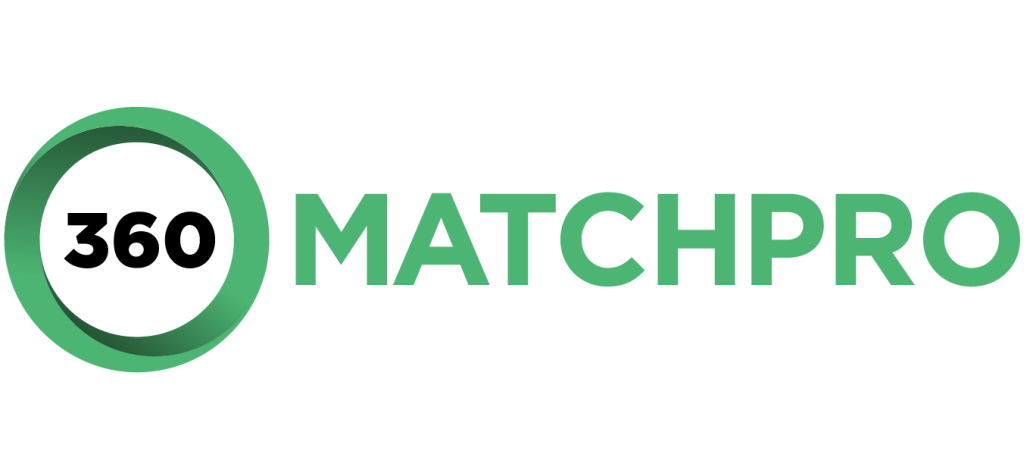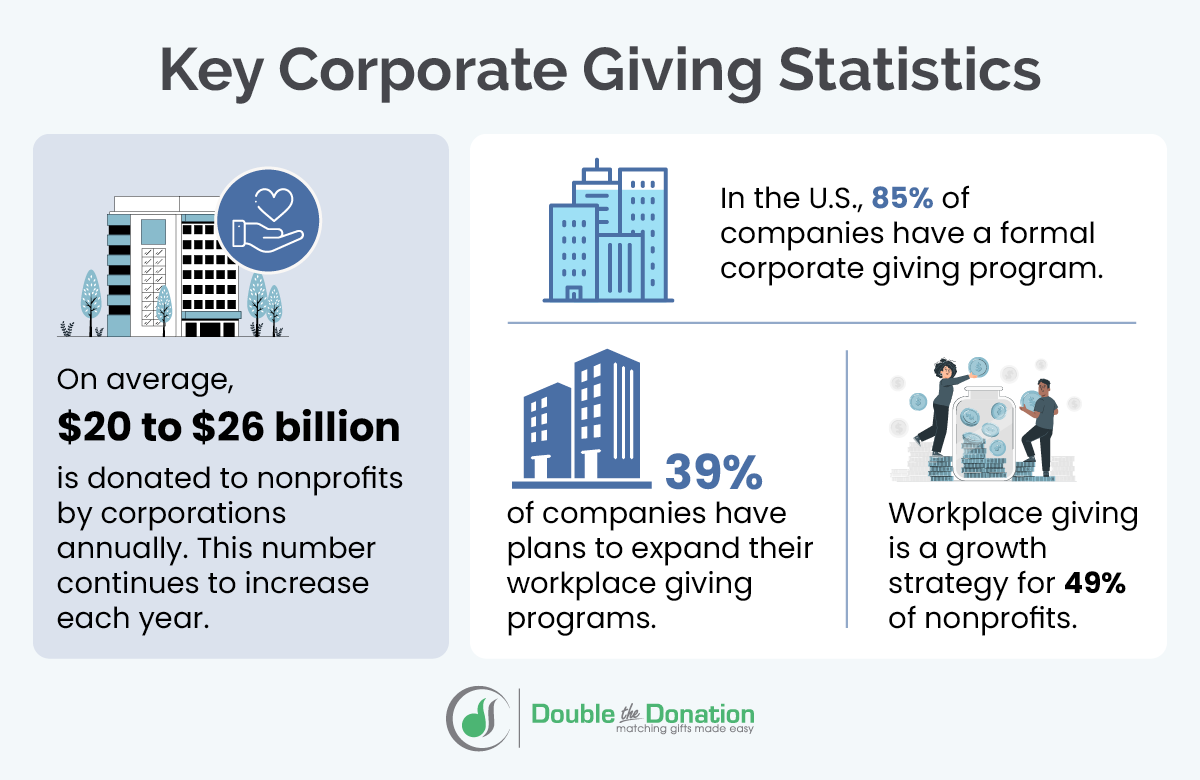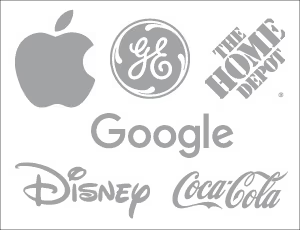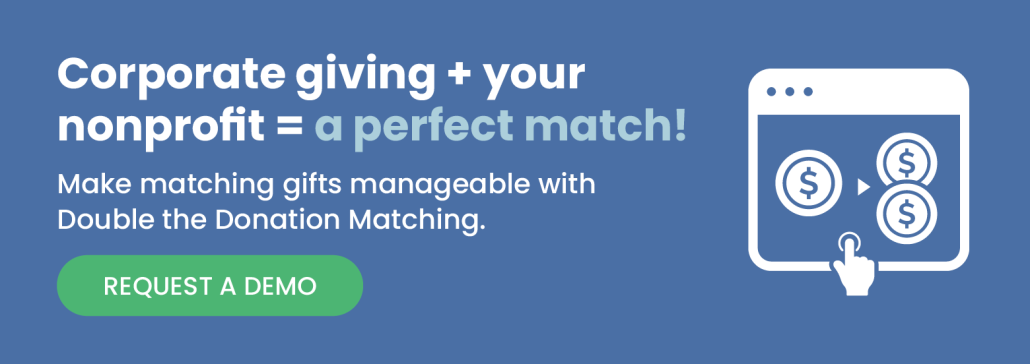What is Corporate Giving?
Corporate Giving Definition
Corporate giving is a form of philanthropy in which corporations contribute to nonprofit causes. This can take the form of both monetary and in-kind contributions.
Commonly driven by employee giving, companies often run multiple types of corporate philanthropy programs simultaneously. Through these programs, corporations may give nonprofits monetary donations, volunteers, tangible goods, and other contributions.
Corporate giving is part of a company’s corporate social responsibility (CSR) program, which is an effort to hold the business accountable to itself and its community. While almost all corporate giving falls under the umbrella of CSR, not all CSR programs include corporate giving. For example, CSR efforts that go beyond corporate philanthropy include maintaining humane working conditions and following environmentally-conscious practices.
Corporate Giving Benefits
Aside from receiving much-needed support, corporate giving can benefit nonprofits in many other ways, including:
- Diversified funding sources: Nonprofits receiving revenue through multiple fundraising channels have increased stability in the event that one source, like grants or contributions from individual donors, underperforms.
- Increased visibility: Corporations often publicize their charitable giving or help nonprofits through cause marketing, putting their partners’ missions in front of corporate audiences.
- Expanded network: Nonprofits that receive donations from corporations often form long-lasting partnerships and open the door to connections with other companies.
Corporate giving also benefits the companies lending support! Businesses can experience the following benefits from implementing a corporate giving program:
- Philanthropic reputation: A commitment to social good causes employees, customers, and community members to see a company in a positive light.
- Employee engagement: Employees value working for socially responsible companies. In fact, 70% of companies believe their employees expect them to be socially responsible. This means corporate giving directly increases employees’ commitment to their jobs.
- Community impact: At its core, corporate giving is a surefire way for a company to give back to the community that has given it business and profitability, strengthening relationships and leading to continued local support and loyalty.
Understanding the impact corporate giving can have is essential for raising more for your organization. Your nonprofit can point out these benefits to potential partners to secure corporate support. You’ll also be well-equipped to make the most of the corporate gifts you receive.
Corporate Giving Statistics
Still not convinced about the power of corporate giving? The numbers don’t lie. Consider the following corporate giving statistics:
- On average, companies donate $20 to $26 billion to nonprofits annually. This number continues to increase each year.
- In the U.S., 85% of companies have a formal corporate giving program.
- 39% of companies have plans to expand their workplace giving programs in the next two years.
- 49% of nonprofits identify workplace giving as a growth strategy.
The top 10 corporations donate more than $2 billion annually to nonprofits, and a large portion is through employee matching gift programs. Let’s explore matching gifts and other types of corporate giving programs.
Types of Corporate Giving Programs
Matching Gifts
A matching gift program is a corporate giving initiative in which a company matches donations made by its employees to nonprofit organizations. Many companies match donations at a 1:1 (or dollar-for-dollar) ratio, though some match at a 2:1 or even 3:1 ratio! That means the company will donate double or triple the original amount.
Here’s how the matching gift process works:

- An individual donates to a nonprofit.
- The donor uses a matching gift database to determine whether their donation is eligible for a company match.
- If eligible, the donor accesses their employer’s matching gift request form via the database or their employer’s CSR portal.
- The donor’s company reviews the completed form and confirms the donation with the nonprofit.
- The company matches the donation.
To simplify the process, your nonprofit can leverage matching gift auto-submission tools that automatically check donors’ eligibility and send a matching gift request to their employer. That way, donors can apply for matching gifts at the press of a button and without completing any extra forms, allowing them to easily maximize their donations.
An estimated $4-7 billion goes unclaimed in matching gift revenue each year, even though more than 26 million individuals work for companies with matching gift programs. This is generally due to donors being unaware of whether their company offers such a program.
Help raise awareness about matching gifts and walk donors through the request process by investing in a matching gift automation platform. This will streamline much of your promotional efforts and help you identify match-eligible donors.
Volunteer Grants
Volunteer grants are a type of corporate giving program wherein companies provide monetary grants to organizations where their employees volunteer. For nonprofits, these grants can bring in funding and help you recruit more volunteers.
Every company has its own unique volunteer grant requirements. In general, most businesses will use one of these four program models:
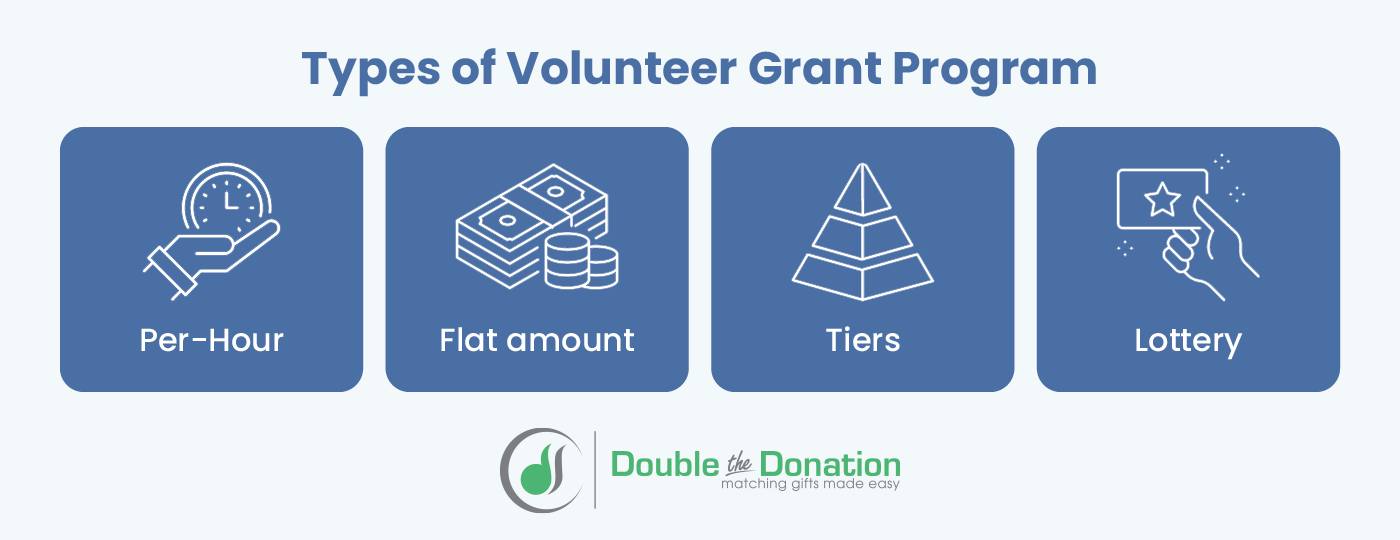
- Per-hour. For every hour an employee volunteers, their employer will donate a set amount to their chosen nonprofit. For example, a volunteer grant program might award nonprofits $15 for every hour an employee volunteers.
- Flat amount. After volunteering a set amount of hours, employees qualify for a volunteer grant. Some flat amount programs allow employees to hit that same target multiple times but many cap the total amount they will donate for any individual employee.
- Tiers. Volunteer grant tier systems combine the per-hour and flat amount approaches. In this system, volunteers earn increasingly higher grants for nonprofits after reaching various hours thresholds. Sometimes, these tiers are consistent, such as offering $500 for every 50 hours volunteered, but usually, they vary. For example, Disney’s VoluntEARS program offers the following tiers: 10-24 hours → $100 grant, 25-49 hours → $250 grant, 50-74 hours → $500 grant, 75-149 hours → $1,000 grant, 150+ hours → $2,000 grant.
- Lottery. In a lottery system, employees who volunteer get to enter their nonprofit of choice into a drawing to receive funding. Lottery systems usually select multiple winners, and many businesses also allow employees to enter a nonprofit multiple times based on how many hours they volunteered.
While these program types vary widely, most corporations still follow the same steps for applying for a volunteer grant:
- A supporter volunteers with a nonprofit.
- The supporter uses a volunteer grant database to determine if they’re eligible for a volunteer grant.
- If their eligibility is confirmed, the supporter uses the database or their employer’s CSR portal to find and submit the grant request forms.
- The supporter’s company reviews the forms and confirms they volunteered with the nonprofit.
- The company will send the nonprofit a monetary grant.
Employees can even work together to earn a team volunteer grant, which can double as a significant nonprofit contribution and an effective team-building exercise!
About 63 million Americans volunteer each year, totaling 7.7 billion hours, which is worth approximately $175 billion annually. Tapping into this network of volunteers within your organization can catapult your revenue.
Due to every corporation having unique volunteer grant program requirements, we recommend that nonprofits interested in seriously pursuing volunteer grants invest in a volunteer grant database. This tool allows each volunteer to find their employer’s guidelines with ease and start the submission process themselves.
Fundraising Matches
Instead of matching individual gifts, some companies match the total amount of money raised in a nonprofit fundraiser. Nonprofits raise funds through special events, such as a walkathon or auction. Then, the company matches the money raised through one large donation.
Automatic Payroll Deductions
Instead of manually making donations, payroll deductions allow employees to opt into making donations automatically through every paycheck. In this program, a portion of employees’ paychecks are extracted automatically and contributed to a nonprofit organization. Corporations usually provide a select number of nonprofits for employees to choose where their donations go.
Annual Giving
Nearly one-quarter of a nonprofit’s yearly revenue is raised in December. The end of the year creates a mood of generosity. Plus, individuals and companies want to earn tax breaks by donating before the end of the year. As such, many companies will make large annual gifts during this time of year. Your nonprofit can track companies that take part in annual giving to make sure you receive funding.
Community Grants
Rather than asking supporters to request donations from their employers, nonprofits may request community grants directly from a corporation. These grants are usually restricted funds and must be spent on specific initiatives. The grant application process can be lengthy and require submitting a written proposal, so consider taking grant writing classes or working with a grant writer.
In-Kind Donations
Aside from monetary donations, many companies have products and services nonprofits can make use of. For example, a technology company might offer much-needed equipment, such as computers and cameras, to a nonprofit’s marketing team. These donations may be given at little or no cost to nonprofits.
Annual Grant Stipends
Annual grant stipends give employees a set amount of money to spend on philanthropic causes. After receiving the stipend, employees can donate it to a nonprofit of their choice.
Top Corporate Giving Companies
The first step to tapping into corporate giving is identifying which of your supporters are eligible for programs like matching gifts and volunteer grants. A few of the top corporate giving companies include:
| Apple | $10,000 | Visit Apple’s corporate giving page. |
| $10,000 | Visit Google’s corporate giving page. | |
| The Home Depot | $3,000 | Visit The Home Depot’s corporate giving page. |
| Disney | $25,000 | Visit Disney’s corporate giving page. |
| Coca-Cola | $20,000 | Visit Coca-Cola’s corporate giving page. |
| General Electric | $5,000 | Visit GE’s corporate giving page. |
| BP | $5,000 | Visit BP’s corporate giving page. |
| Microsoft | $15,000 | Visit Microsoft’s corporate giving page. |
| JPMorgan | $1,000 | Visit JPMorgan’s corporate giving page. |
| Verizon | $5,000 | Visit Verizon’s corporate giving page. |
Corporate Giving Trends
Corporate Giving Trend #1:
Expanded Nonprofit Eligibility
Many companies are expanding their matching gift programs to include any type of 501(c)(3) nonprofit rather than focusing on specific categories of nonprofits. This trend allows more employees to give to the specific causes they personally care about, increasing participation in employee giving programs.
Examples of Expanded Nonprofit Eligibility
Caterpillar Inc. is the world’s largest construction equipment manufacturer. The company previously only matched donations to higher education institutions. However, this year they have expanded to match donations to most 501(c)(3) organizations.
The Caterpillar Foundation offers a year-round matching gift program at a 1:1 ratio, and each employee can request an annual combined total maximum match of $10,000 per calendar year.
Pioneer Natural Resources is an independent oil and gas exploration and production company. The company previously only matched donations to higher education institutions, but in recent years, they have expanded to also match donations to most 501(c)(3) nonprofits.
Pioneer Natural Resources will match a maximum of $5,000 at a 1:1 ratio per year for active employees.
Corporate Giving Trend #2:
Increased Monthly Giving
Recurring monthly gifts are one of the most popular ways for individual donors and corporations to give. Monthly giving provides reliable revenue for nonprofits while also spreading out donations throughout the year to ensure budgets stay balanced.
Examples of Increased Monthly Giving
Many companies take advantage of automatic payroll deductions to allow employees to donate directly from their paychecks automatically and receive tax benefits.
Companies are also leveraging matching gift programs to further incentivize their employees to participate in monthly giving. While most companies have annual maximums, it’s usually expected that employees will reach this maximum through multiple donations throughout the year rather than through one major gift.
Corporate Giving Trend #3:
Higher Employee Participation
Today, more employees want to participate in corporate giving and actively choose to work for companies that share their values. In fact, corporate giving reports find that 70% of Millennials and 74% of Gen Z rank their employer’s strong philanthropic purpose as more important than their paycheck.
This means more companies are leveraging corporate giving as a way to engage their employees and attract new recruits.
Examples of Higher Employee Participation
Companies use software to track the results of their corporate giving programs, which they can then share with stakeholders like employees, customers, and investors. These platforms also allow companies to track donations and volunteer hours, set yearly philanthropy goals, and generate reports that demonstrate impact.
Using data collected from these tools, corporate giving vendor Benevity discovered a year-over-year increase in reported volunteer hours from 2020 to 2023. In 2020, volunteer hours totaled 6.9 million; in 2023, this number rose to 20.2 million.
Corporate Giving Trend #4:
More Consumer Influence
In recent years, consumers have demanded that companies address social issues, which has resulted in corporations speaking out about pressing issues and making commitments to advance social good.
Examples of More Consumer Influence
Consumers are more inclined to do business with companies that share their values. For that reason, companies have adapted their corporate giving and volunteer programs to accommodate employees who want to give and volunteer for issues they feel passionate about.
For example, in 2016, Ben & Jerry’s launched an exclusive ice cream flavor, Empower Mint, on the anniversary of the Supreme Court Decision Brown vs. Board of Education. As part of this promotion, Ben & Jerry’s also donated a portion of the proceeds of each sale to the NAACP.
Corporate Giving Software:
Grow Your Revenue with Double the Donation Matching
If you’re a large nonprofit or university that generates more than $25,000 annually in matching gift revenue, you may be missing out on revenue from matching gifts.
Investing in corporate giving software helps automate the entire matching gift process. This means you can easily identify matching gift opportunities and push more gifts to completion to secure funding.
How Double the Donation Matching Works
When it comes to matching gifts and volunteer grants, you may be low on staff members dedicated to driving in revenue from these areas. For that reason, Double the Donation Matching can serve as your own corporate giving team, making outreach and tracking metrics easier than ever.
Our auto-submission tool further simplifies the matching gift process, giving your team more time to focus on what’s most important: your mission. Here’s how it works:

- A supporter donates to the nonprofit of their choice.
- The platform asks for the supporter’s employer information. Donors can also search for their employer in a company name search tool widget on your site.
- If the donor is eligible for a matching gift, the platform will provide their employer’s matching gift guidelines explaining the next steps the supporter can take.
- The supporter will be asked to enter their email address.
- Finally, the matching gift request is processed!
The platform also tracks the progress of the match from start to finish, which allows you to better leverage the information from your matching gifts outreach.
Benefits of Double the Donation Matching
Whether you’re searching for ways to maximize your matching gift revenue or secure more volunteer grants, you can benefit from investing in tools like the Double the Donation Matching and Volunteering modules to streamline every step of these processes.
Benefits of using Double the Donation’s modules include:
- More matching gift revenue opportunities. Double the Donation Matching automatically analyzes the information supporters provide in their donation forms to assess their matching gift eligibility. This means more donors will learn if they qualify for a matching gift and go on to submit a match request.
- More matches driven to completion. Because the right information is provided to the right donor at the right time, Double the Donation Matching automatic targeted follow-up messages drive completed submissions far better than manual emailing can.
- More time for top opportunities. Rather than spending time on smaller-value matching gifts, Double the Donation Matching automates this process and flags the highest-value opportunities so your team can personalize communication for valuable match-eligible donations.
Double the Donation’s Matching and Volunteering modules streamline your corporate giving identification process and marketing outreach while also tracking the matching gift process through to completion for each donor. Additionally, you can customize your email outreach using your organization’s branding and email domain, which means your donors will know the outreach came from you.
Additional Corporate Giving Resources
Matching Gifts: Your Guide to Automation
Want to learn more about matching gifts and automation in particular?
Check out our expert guide to matching gifts!
Top Matching Gift Companies: Find Your Match
Your donors may be linked to some of the top matching gift companies.
Identify some key giving opportunities!
Corporate Philanthropy: The Ultimate Guide to Giving
Corporate philanthropy makes a huge impact on all kinds of nonprofits.
Learn the basics with Double the Donation!
